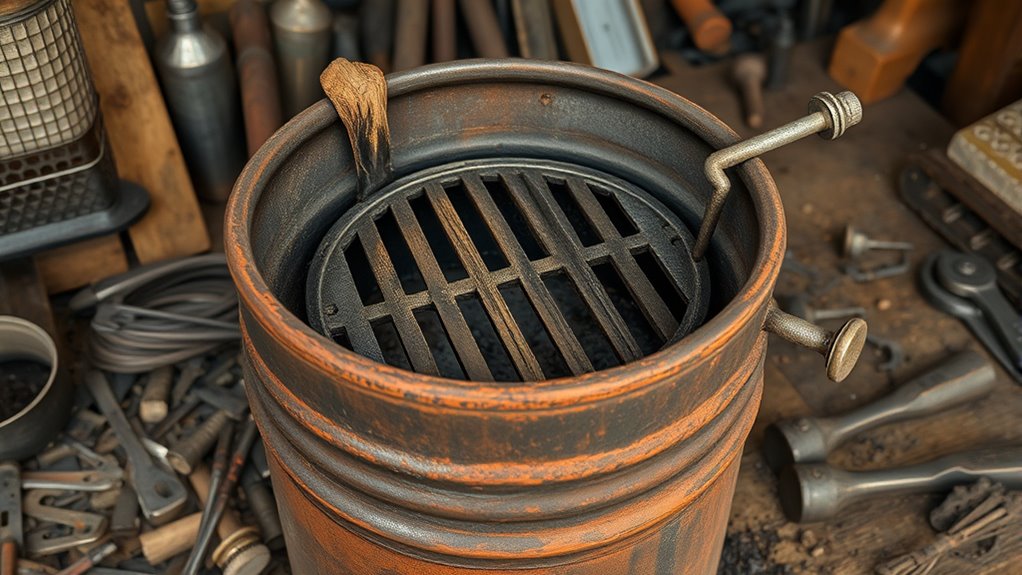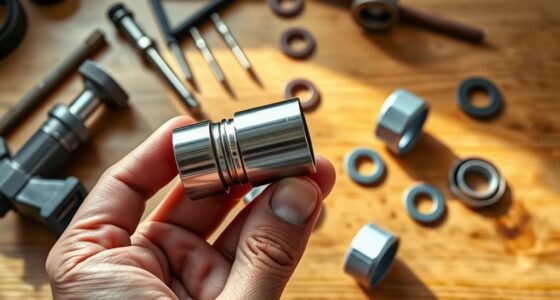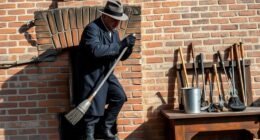To convert an old barrel into a workshop stove, start by choosing a sturdy, chemical-free steel barrel and thoroughly clean it. Plan and mark openings for a door, vents, and a chimney pipe, using appropriate cutting tools while wearing safety gear. Guarantee all modifications are precise for safety and functionality. Use heat-resistant components, and double-check your work before welding or assembling. If you keep following these steps, you’ll find out more tips to build a safe, effective stove.
Key Takeaways
- Select a high-quality, rust-free steel barrel suitable for high temperatures, ensuring it’s clean and free of hazardous residues.
- Plan and measure openings for the door, vents, and chimney before cutting, using appropriate tools like an angle grinder.
- Wear safety gear and work in a well-ventilated area during cutting, welding, and assembly to prevent accidents.
- Use heat-resistant, compatible materials for vents, door, and chimney to ensure safety and durability.
- Properly assemble and seal all components, testing for leaks and stability before regular use.

Transforming an old barrel into a functional workshop stove is a practical way to repurpose materials and save money. However, before you start, it’s imperative to prioritize safety precautions to prevent accidents and ensure your project is successful. Working with metal and fire involves risks, so wearing protective gear such as gloves, goggles, and a dust mask is essential. Also, keep your workspace well-ventilated, especially if you’re cutting or welding, to avoid inhaling harmful fumes. Clear the area of flammable materials, and have a fire extinguisher nearby in case of emergencies. Taking these precautions helps protect you and others around you during the transformation process.
Material selection is a pivotal step in converting an old barrel into a workshop stove. Not all barrels are suitable; aim for one made of high-quality, thick steel that can withstand high temperatures without warping or releasing harmful fumes. Avoid barrels with residues of paint, chemicals, or other hazardous substances, as heating these can produce toxic fumes. If the barrel was used to store chemicals or oils, it’s necessary to thoroughly clean and, if possible, strip any coatings or residues before proceeding. Using a steel barrel that’s structurally sound, free of rust, and free of contaminants will guarantee your stove is safe and durable.
When selecting your materials, focus on the type of metal, ensuring it’s non-corrosive and heat-resistant. You’ll also need to gather additional supplies such as vents, a door, and a chimney pipe, which should be made from heat-resistant materials and compatible with your barrel’s size. The quality of these components directly impacts the efficiency and safety of your finished stove. Remember, choosing the right materials from the start reduces the chance of costly mistakes and unsafe conditions later on.
Once you’ve selected the proper barrel and gathered your materials, it’s necessary to plan your modifications carefully. Cut openings for the door, vents, and chimney using appropriate tools, such as a metal cutter or angle grinder. Always wear your safety gear during these steps, and double-check your measurements before making cuts. Proper material selection combined with adherence to safety precautions ensures that your workshop stove will not only be functional but also safe to operate for years to come. By paying close attention to these details, you’re setting yourself up for a successful project that’s economical, environmentally friendly, and tailored to your workshop needs.
Frequently Asked Questions
What Safety Precautions Are Necessary During Conversion?
You should wear protective gear and work in a well-ventilated area to guarantee safety. Keep flammable materials away from the conversion site and handle fuels carefully. Check all electrical connections for safety, avoiding exposed wires or faulty components. Disconnect power sources before working on electrical parts, and use proper tools. Always follow safety guidelines to prevent accidents, fires, or electrical hazards during the conversion process.
Can the Barrel Be Used for Outdoor or Indoor Settings?
You can use the converted barrel for outdoor or indoor settings, but consider barrel aesthetics and safety. Outdoors, it’s ideal because it reduces concerns about ventilation and environmental impact. Indoors, guarantee proper ventilation and fire safety measures are in place to minimize environmental impact and avoid hazards. Always check local regulations, and consider how the barrel’s appearance fits your space, balancing functionality with environmental responsibility.
How Do I Prevent Rust and Corrosion Over Time?
Imagine your workshop stove rusting after just a year. To prevent rust and corrosion, you should regularly apply high-temperature paint or a rust-resistant coating, especially after cleaning. Keep the barrel dry and store it in a sheltered area when not in use. Using rust prevention techniques like galvanization or coating with oil also helps control corrosion, ensuring your stove stays durable and safe for years.
What Are the Best Materials for Making the Stove’s Internal Parts?
You should use high-quality, heat-resistant materials like cast iron or stainless steel for the stove’s internal parts, as they withstand high temperatures and resist rust. Incorporate insulation materials such as firebricks or ceramic blankets to improve efficiency and safety. Apply proper sealing techniques with high-temperature gaskets and heat-resistant caulks to prevent leaks and guarantee durability. These choices keep your stove safe, efficient, and long-lasting.
How Do I Ensure Proper Ventilation During Operation?
To guarantee proper ventilation during operation, you should install a ventilation exhaust system to direct smoke and fumes outside safely. Manage airflow by adding adjustable vents or dampers, allowing you to control combustion and heat output. Keep the exhaust clear of obstructions and regularly check for leaks. Good airflow management prevents dangerous buildup of smoke and gases, creating a safer, more efficient workspace during stove use.
Conclusion
Now that you’ve transformed that old barrel into a functional workshop stove, imagine the possibilities. But wait—there’s one essential step you haven’t tackled yet. Will you add a chimney to vent the smoke, or will you keep things simple? The choice is yours, and it could change everything. Get ready to see your project come to life in ways you never expected. The next move could make all the difference—are you ready?










